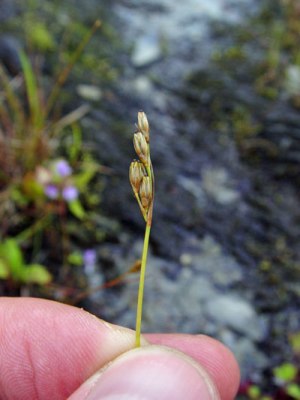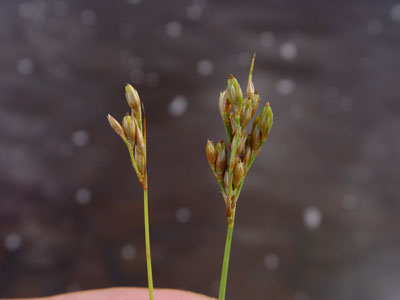DACF Home → Bureaus & Programs → Maine Natural Areas Program → Communities, Plants, and Animals → Rare Plants → Juncus vaseyi

Juncus vaseyi Engelm.
Vasey's Rush
- State Rank: S1
- Global Rank: G5
- State Status: Endangered
Habitat: Damp shores, thickets, etc.
Range: Nova Scotia to British Columbia, south to Maine, northern New York, Indiana, and Colorado.
Aids to Identification: Rushes are recognized by their grass-like morphology, small flowers with 6 inconspicuous sepals and petals (called tepals) and 3-valved capsules. Juncus vaseyi belongs to a group of rushes that are perennial, have terete leaves (circular in cross-section), and each flower borne separately on a short pedicel. Juncus vaseyi is separated from the similar Juncus greenei, which is common in Maine, by its larger capsules (4.1-5.4 mm long) and seeds with prominent white, tail-like appendages at each end (visible with a 10x handlens). Juncus greenei has smaller capsules (3-4 mm long) and seeds with a minute white tip at each end.

Ecological characteristics: Known to occur in Maine in a variety of habitats, from the rim of gorges to dry soil.
Phenology: Fruits July - August.
Family: Juncaceae
Synonyms: Juncus greenei Oakes & Tuckerman var. vaseyi (Engelm.) Boivin.
Known Distribution in Maine: This rare plant has been documented from a total of 8 town(s) in the following county(ies): Aroostook, Franklin, Penobscot, Piscataquis, Washington.
Reason(s) for rarity: At southern limit of range.
Conservation considerations: One known population has succumbed to conversion of its habitat to residential or commercial use; others are vulnerable.
For more information, see the Native Plant Trust's Conservation Plan for Juncus vaseyi.